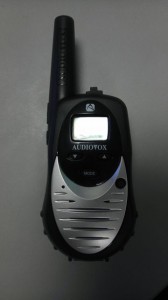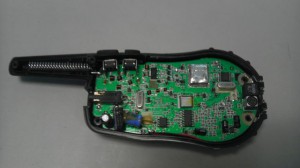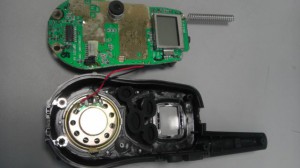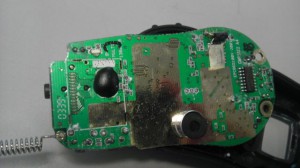Week 5 lab report
Objective: Disassemble an Audiovox walkie-talkie, inspect and document the components inside of it, and then put it back together in working condition.
Materials: Selection of screwdrivers, small needle nose pliers, Audiovox GMRS122-2
External I/O:
- 3.5mm stereo jack for charger, external microphone, or external speaker
- PTT (Push to Talk) button
- M button (Microphone? Mute?)
- Up/Down buttons
- Mode button
- Power button
- LCD screen
Disassembling:
- Remove battery cover
- Remove 5 screws – 2 from below battery, 1 at top of radio, 2 on antenna. The top antenna screw is smaller than the others.
- Back cover easily lifts off after screws are removed.
- Circuit board easily lifts straight out of front cover, pair of wires connect to a speaker that is permanently attached to cover.
- To take off LCD screen, look for 4 twisted metal tabs. Carefully straighten out tab with needlenose pliers and pry off screen.
Inspection:
- Lots of tiny SMT capacitors
- Central processor is not evident – variety of scattered IC chips. A CPU may be inside a large metal shield, which cannot be removed without significant desoldering.
- Removing LCD screen reveals a large blob of epoxy which may be covering a CPU.
- Bottom of board has two trim pots adjustable with a screwdriver, presumably for radio frequency selection.
- Number of small springs/metal coils close to antenna, presumably having to do with frequency control.
Results:
- Although we put the radio back together, we didn’t have batteries so have no idea if the radio survived.
- I was intrigued at the number of small metal coils, and wonder about their exact purpose. They were in the same corner as the antenna, so I’m guessing they have something to do with controlling signals, perhaps somehow filtering out electronic noise.
- I was also intrigued by the two trim pots. It makes you wonder what other frequencies the radio may be capable of listening or transmitting on, perhaps even frequencies you’re not “supposed” to be on?







